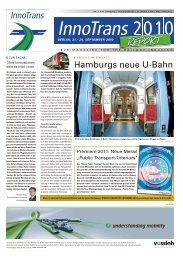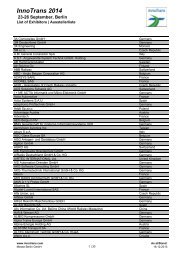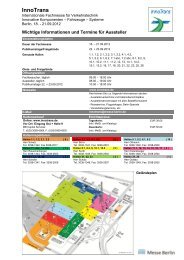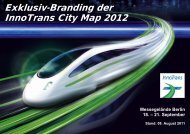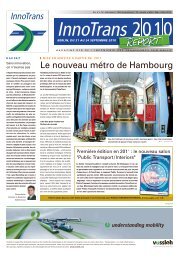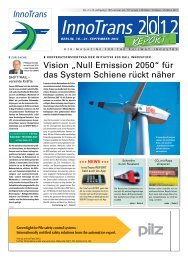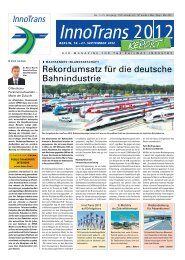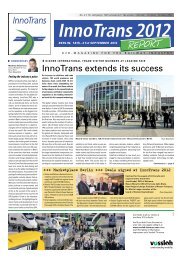here (PDF, 24.8 MB) - InnoTrans
here (PDF, 24.8 MB) - InnoTrans
here (PDF, 24.8 MB) - InnoTrans
You also want an ePaper? Increase the reach of your titles
YUMPU automatically turns print PDFs into web optimized ePapers that Google loves.
F<br />
Fraunhofer-IPM: Measuring the geometry of moving trains<br />
Rail accidents have a particularly severe impact at critical points such<br />
as tunnels or w<strong>here</strong> railways enter densely populated areas. It is at such<br />
points that a profile scanner developed by Fraunhofer-IPM can now measure<br />
the geometry of passing trains. The Sector Profile Scanner SPS identifies<br />
possible incursions into the clearance outline, for example as a result<br />
of shifting loads, open loading hatches or detached couplings. The<br />
four scanners attached to masts on the measuring portal register the<br />
shape of the train along with the end surfaces of the wagons and gaps<br />
between them. The SPS records a profile every 3.5 centimetres on trains<br />
travelling at 100 km/h. In approximately one millisecond the scanner registers<br />
900 measuring points and then provides an adequate resolution<br />
at full speed. The measurement data is used to generate a 3D model of<br />
the train, which is then compared with nominal profiles stored in the system<br />
in order to create the required train geometry. In addition to SPS numerous<br />
improvements and additional functions for its various rail measurement<br />
systems are also being displayed by Fraunhofer-IPM.<br />
Fraunhofer-Institut für Physikalische Messtechnik IPM,<br />
D-Freiburg im Breisgau<br />
Hall 4.1, Booth 225<br />
Tobias Steinhäußer<br />
+49 (0)89-12051308<br />
tobias.steinhaeusser@zv.fraunhofer.de<br />
www.ipm.fraunhofer.de<br />
SPS sector profile scanner<br />
Fraunhofer-IZFP: Thermographic testing of train wheels<br />
The advantages of testing train wheels by means of inductively induced<br />
thermography are being demonstrated by the Fraunhofer Institute<br />
for Non-Destructive Testing Methods IZFP at <strong>InnoTrans</strong> 2012.<br />
This method involves rotating a wheel and using a system of coils to<br />
induce eddy currents, which spread out in areas close to the surface.<br />
Any faults such as cracks will interfere with the spread of these eddy<br />
currents, causing characteristic temperature fields in the surrounding<br />
area. These can be recorded using a thermal imaging camera.<br />
In contrast to the magnetic powder test which is currently used for<br />
testing surfaces, it permits automated recording and objective evaluation<br />
of the image data. Thermography also reveals hidden faults.<br />
Unlike magnetic powder testing the readings obtained provide information<br />
about the geometry of the faults, and especially about the<br />
depth of any surface cracks. The process is also eco-friendly because<br />
it does not rely on the use of any chemical substances in order<br />
to indicate faults.<br />
Fraunhofer-Institut Zerstörungsfreie Prüfverfahren IZFP,<br />
D-Saarbrücken<br />
Hall 4.1, Booth 225<br />
Tobias Steinhäußer<br />
+49 (0)89-12051308<br />
tobias.steinhaeusser@zv.fraunhofer.de<br />
www.izfp.fraunhofer.de<br />
Simulation of temperature distribution in the area around a crack<br />
532




